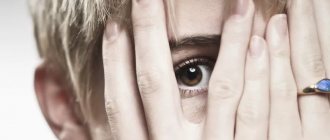Definition
Anxiety is a psychological characteristic of an individual, expressed in constant worry and anticipation of danger. The definition of anxiety was first given by Sigmund Freud, who formulated it as an emotional experience of a negative nature associated with a feeling of uncertainty and helplessness.
In psychology, this concept is twofold: it is an emotion and a personality trait. All people experience short-term feelings of anxiety. It helps a person adapt to living conditions. Feelings of anxiety as a character trait lead to disruptions in individual development and interfere with living a full life.
The difference between anxiety and worry
Anxiety is a complex negative emotion that combines fear, shame, guilt, sadness, and anger. It appears in a person in situations that pose a potential threat and is a short-term defense mechanism that forces a person to react to danger.
Anxious people often feel unfounded nervousness. The feeling of fear about what could happen makes them unable to react normally to what is happening.
Are you ready to stop thinking about your problem and finally move on to real actions that will help you get rid of your problems once and for all? Then perhaps you will be interested in this article .
The causes of anxiety are real or contrived by man; they are not always explainable. An overly anxious person often perceives the situation inadequately. He is afraid of an upcoming trip or a possible presentation at a seminar, is upset because of a slight weight gain or a bad grade at school.
For your information! Anxiety is a stable personality quality, anxiety is a temporary state. Anxiety reflects the frequency with which a person experiences feelings of anxiety.
The concept of anxiety, types and causes of anxiety, methodological development on the topic
Popova Roza Viktorovna, educational psychologist
Topic: “The concept of anxiety, types and causes of anxiety”
Recently, the number of anxious children characterized by increased anxiety, uncertainty, and emotional instability has increased. The emergence and consolidation of anxiety is associated with the dissatisfaction of the child’s age-related needs.
It is anxiety, as noted by researchers (A.M. Prikhozhan, I.A. Musina, etc.) and practical psychologists [1], that underlies a number of psychological difficulties in childhood. Wenger A.L. believes that when working with anxious children, one should take into account their specific attitude to success, failure, evaluation and results. As is known, such children are extremely sensitive to the results of their own activities, are painfully afraid and avoid failure. At the same time, it is difficult for them to evaluate the results of their activities themselves and expect this assessment from an adult [9].
Emotions and feelings are a reflection of reality in the form of experiences. Various forms of experiencing feelings (emotions, affects, moods, stress, passions, etc.) collectively form the emotional sphere of a person [14].
There are such types of feelings as moral, intellectual and aesthetic. According to the classification proposed by K. Izard, emotions are distinguished between fundamental and derivative. The fundamental ones include: 1) interest-excitement, 2) joy, 3) surprise, 4) grief-suffering, 5) anger, 6) disgust, 7) contempt, fear, 9) shame, 10) guilt [14, p. 57].
According to the classification proposed by K. Izard, emotions are distinguished between fundamental and derivative. The fundamental ones include: 1) interest-excitement, 2) joy, 3) surprise, 4) grief-suffering, 5) anger, 6) disgust, 7) contempt, fear, 9) shame, 10) guilt [14, p. 57].
The rest are derivatives. From the combination of fundamental emotions arises such a complex emotional state as anxiety, which can combine fear, anger, guilt, and interest-excitement [14, p.66].
In the psychological literature, one can find different definitions of the concept of anxiety, although most researchers agree on the need to consider it differentially - as a situational phenomenon and as a personal characteristic, taking into account the transition state and its dynamics.
So, A.M. Prikhozhan points out that anxiety is “the experience of emotional discomfort associated with the expectation of trouble, with a premonition of impending danger” [37, p. 13].
Anxiety is distinguished as an emotional state and as a stable property, personality trait or temperament.
According to the definition of R.S. Nemova: “Anxiety is a constantly or situationally manifested property of a person to come in a state of heightened anxiety, to experience fear and anxiety in specific social situations” [30].
L.A. Kitaev-Smyk, in turn, is about situational anxiety, proposed by Spielberg.”
According to the definition of A.V. Petrovsky: “Anxiety is an individual’s tendency to experience anxiety, characterized by a low threshold for the occurrence of an anxiety reaction; one of the main parameters of individual differences. Anxiety is usually increased in neuropsychic and severe somatic diseases, as well as in healthy people experiencing the consequences of psychotrauma, in many groups of people with deviant subjective manifestations of personal distress” [8, p.215].
G.G. Arakelov, N.E. Lysenko, E.E. Schott, in turn, note that anxiety is a polysemantic psychological term that describes both a certain state of individuals at a limited point in time, and a stable property of any person. An analysis of the literature of recent years allows us to consider anxiety from different points of view, allowing for the assertion that increased anxiety arises and is realized as a result of a complex interaction of cognitive, affective and behavioral reactions provoked when a person is exposed to various stresses [3].
A certain level of anxiety is a natural and obligatory feature of an individual’s active activity. Each person has his own optimal or desired level of anxiety - this is the so-called useful anxiety [42, p.234]. A person’s assessment of his condition in this regard is for him an essential component of self-control and self-education. However, an increased level of anxiety is a subjective manifestation of personal distress.
The manifestations of anxiety in different situations are not the same. In some cases, people tend to behave anxiously always and everywhere, in others they reveal their anxiety only from time to time, depending on the circumstances [30, p.68].
Situationally stable manifestations of anxiety are usually called personal and associated with the presence of a corresponding personality trait in a person (the so-called “personal anxiety”). This is a stable individual characteristic that reflects the subject’s predisposition to anxiety and presupposes his tendency to perceive a fairly wide “fan” of situations as threatening, responding to each of them with a specific reaction. As a predisposition, personal anxiety is activated when certain stimuli are perceived by a person as dangerous, associated with specific situations, threats to his prestige, self-esteem, self-esteem [42, p.234].
Situationally variable manifestations of anxiety are called situational, and the personality trait exhibiting this kind of anxiety is referred to as “situational anxiety.” This state is characterized by subjectively experienced emotions: tension, anxiety, concern, nervousness. This condition occurs as an emotional reaction to a stressful situation and can vary in intensity and dynamic over time.
Individuals classified as highly anxious tend to perceive a threat to their self-esteem and functioning in a wide range of situations and react very intensely, with a pronounced state of anxiety [42, p.229].
The behavior of highly anxious people in activities aimed at achieving success has the following features:
– high-anxiety individuals react emotionally more acutely than low-anxiety individuals to messages about failure;
– people with high anxiety work worse than people with low anxiety in stressful situations or when there is a shortage of time allotted to solve a problem;
– Fear of failure is a characteristic feature of highly anxious people. This fear dominates their desire to achieve success;
– motivation to achieve success prevails among low-anxiety people. It usually outweighs the fear of possible failure;
– for highly anxious people, messages about success have greater stimulating power than messages about failure;
– low-anxiety people are more stimulated by messages about failure.
Personal anxiety predisposes an individual to perceive and evaluate many objectively safe situations as those that pose a threat.
A person’s activity in a specific situation depends not only on the situation itself, on the presence or absence of personal anxiety in the individual, but also on the situational anxiety that arises in a given person in a given situation under the influence of developing circumstances.
The impact of the current situation, a person’s own needs, thoughts and feelings, the characteristics of his anxiety as personal anxiety determine his cognitive assessment of the situation that has arisen. This assessment, in turn, causes certain emotions (activation of the autonomic nervous system and increased state of situational anxiety along with expectations of possible failure). Information about all this is transmitted through neural feedback mechanisms to the human cerebral cortex, influencing his thoughts, needs and feelings.
The same cognitive assessment of the situation simultaneously and automatically causes the body to react to threatening stimuli, which leads to the emergence of countermeasures and corresponding responses aimed at reducing the resulting situational anxiety. The result of all this directly affects the activities performed. This activity is directly dependent on the state of anxiety, which could not be overcome with the help of the responses and countermeasures taken, as well as an adequate cognitive assessment of the situation [42, p. 415].
Thus, a person’s activity in an anxiety-generating situation directly depends on the strength of situational anxiety, the effectiveness of countermeasures taken to reduce it, and the accuracy of the cognitive assessment of the situation.
By a form of anxiety we understand a special combination of the nature of experience, awareness, verbal and nonverbal expression in the characteristics of behavior, communication and activity. The form of anxiety manifests itself in the spontaneously developing ways of overcoming and compensating it, as well as in the attitude of the child and adolescent to this experience.
The study of forms of anxiety is carried out in the process of individual and group practical psychological work with children and adolescents. It is known that there are two categories of anxiety: 1) open - consciously experienced and manifested in behavior and activity in the form of a state of anxiety; 2) hidden - unconscious to varying degrees, manifested either by excessive calm, insensitivity to real disadvantage and even denial of it, or indirectly through specific modes of behavior [22].
Within these categories, various forms of anxiety were identified and subjected to special analysis. There are three forms of open anxiety.
1. Acute, unregulated or poorly regulated anxiety - strong, conscious, manifested externally through symptoms of anxiety, the individual cannot cope with it on his own.
2. Regulated and compensated anxiety, in which children independently develop fairly effective ways to cope with their anxiety. According to the characteristics of the methods used for these purposes, two subforms were distinguished within this form:
a) reducing anxiety levels and
b) using it to stimulate one’s own activity, increase activity. This form of anxiety occurs mainly in primary school and early adolescence, i.e. in periods characterized as stable.
An important characteristic of both forms is that anxiety is assessed by children as an unpleasant, difficult experience that they would like to get rid of.
3. Cultivated anxiety - in this case, unlike those stated above, anxiety is recognized and experienced as a valuable quality for the individual that allows one to achieve what they want. Cultivated anxiety comes in several forms. Firstly, it can be recognized by the individual as the main regulator of his activity, ensuring his organization and responsibility. In this it coincides with form 2.b; the differences concern, as noted, only the assessment of this experience. Secondly, it can act as a certain ideological and value setting. Thirdly, it often manifests itself in the search for a certain “conditional benefit from the presence of anxiety and is expressed through an increase in symptoms. In some cases, one subject had two or even all three options simultaneously.
The form that we conventionally called “magical” can be considered as a type of cultivated anxiety. In this case, the child or teenager, as it were, “conjures evil forces” by constantly replaying in his mind the most disturbing events, constant conversations about them, without, however, freeing himself from the fear of them, but further strengthening it through the mechanism of the “vicious psychological circle.” "
Speaking about forms of anxiety, one cannot help but touch upon the problem of so-called “masked” anxiety. “Masks” of anxiety are those forms of behavior that have the form of pronounced manifestations of personal characteristics generated by anxiety, allowing a person to experience it in a softened form and not express it outwardly. Aggression, dependence, apathy, excessive daydreaming, etc. are most often described as such “masks.”
There are aggressive-anxious and dependent-anxious types (with varying degrees of awareness of anxiety). The aggressive-anxious type is most often found in preschool and adolescence with both open and hidden forms of anxiety, both as a direct expression of aggressive forms of behavior. The anxiety-dependent type is most often found in open forms of anxiety, especially in acute, unregulated and cultivated forms [22].
So, anxiety is the experience of emotional discomfort associated with the expectation of trouble, with a premonition of impending danger.
There are two main types of anxiety. The first of them is the so-called situational anxiety, i.e. generated by some specific situation that objectively causes concern. Another type is personal anxiety. It can be considered as a personal trait, manifested in a constant tendency to experience anxiety in a wide variety of life situations, including those that objectively do not lead to this.
A special type of anxiety is school anxiety. This is a common way to describe children’s negative experiences associated with school. School anxiety manifests itself in the following way: the child throws tantrums in the morning and flatly refuses to go to school; parents cannot force their child to do homework; the child is terrified of getting a bad grade, despite the fact that he is mastering the school curriculum well, and is afraid of the teacher; he has nightmares related to school, etc.
Let us turn to the issue of anxiety in children of primary school age.
Disorders of emotional development in primary school age are caused by two groups of reasons:
Constitutional reasons (type of the child’s nervous system, biotonus, somatic features, that is, disruption of the functioning of any organs).
Genetic factors play an important role in the development of psychophysiological characteristics of the nervous system. Being a genetically fixed “specialization” of the style of behavior in extreme situations, temperament can determine the nature of the child’s experiences and internal conflict in response to psychological stress factors, but its action alone is not enough to cause certain emotional disorders to occur.
Features of the child’s interaction with the social environment [16, p.22].
A junior schoolchild has his own experience of communicating with adults, peers and a group that is especially important to him - his family, and this experience can be unfavorable:
– if a child is systematically subjected to negative evaluations by an adult, he is forced to repress into the unconscious a large amount of information coming from the environment. New experiences that do not coincide with the structure of his “I-concept” are perceived negatively by him, as a result of which the child finds himself in a stressful situation;
– with dysfunctional relationships with peers, emotional experiences arise that are characterized by severity and duration: disappointment, resentment, anger;
- family conflicts, different demands on the child, lack of understanding of his interests - can also cause negative experiences in him. The following types of parental attitudes are unfavorable for the emotional and personal development of a primary school student: rejection, overprotection, treating the child according to the principle of a double bond, over-demandingness, avoidance of communication, etc. Among the emotional traits that develop under the influence of such parental relationships are aggression, self-aggressiveness, lack of ability for emotional decentration, feelings of anxiety, suspiciousness, emotional instability in communicating with people. Whereas close, intense emotional contacts, in which the child is “the object of a benevolent, but demanding, evaluative attitude, ... form confidently optimistic personal expectations in him” [16, p. 82].
Relationships in the family are at the epicenter of theoretical and experimental research, focusing on the influence of the environment as a risk factor for the occurrence of emotional distress in children. Any emotional disturbance in a child is considered a product and indicator of a family abnormality and is considered a disturbance for the entire family. Most psychological concepts do not dispute this; the difference lies in which aspect of this relationship is considered to be decisive. Violations are recorded mainly at the personal level (neurotic disorders, adaptation disorders, etc.).
According to the pathogenetic concept of V. N. Myasishchev, “... affective-volitional disorders represent a secondary product of the child’s relationships with others, a product of internal tension arising in connection with this, a product of incorrect attitudes and relationships” [29, p. 66].
V. N. Myasishchev’s position on the pathogenic role of family conflicts and the inconsistency of the parents’ relationship with the child is confirmed and concretized by a number of domestic clinical and psychological studies aimed at identifying unfavorable factors in upbringing, the intra-family atmosphere that accompany the child’s emotional distress.
Thus, V.I. Garbuzov, A.I. Zakharov, D.N. Isaev identify three main types of improper upbringing, which is the decisive factor that shapes the personality traits of children predisposing to the occurrence of neurotic reactions:
Rejecting (non-acceptance). Conditioned by a number of conscious and more often unconscious factors, it implies excessive demands, strict regulation and control, or a lack of control due to connivance.
Hypersocializing. It manifests itself in excessive concern for the future of the child and his family, arising from the parents’ anxious suspicion regarding the health of the child and other family members, and the child’s social status.
Egocentric. The idea of “I am big” is imposed on the child as a self-pressing value for others [10;12; 15].
The work of A. Ya. Varg describes three pathogenic types of parental relationships that are unfavorable for the child: symbiotic, authoritarian and emotionally rejecting, characterized by attributing pain and personal failure to the child [7, p. 112].
Among the causes of school anxiety are the following.
The child is not emotionally ready for school. In this case, even the most benevolent teacher and the most successful children's team can be perceived by the child as something hostile and alien to him. Studying will be perceived as a duty, which will lead to protest reactions, possibly conflicts with parents and teachers, and the mere mention of school will not cause anything in the child except anxiety and hostility. Of course, such an outcome does not always occur, and there are quite frequent cases when a child, having found himself in a good class with an understanding teacher, “matures” as his studies progress.
The child is not prepared for school intellectually, and this often means that no matter how much the child strives to be a student, gain knowledge, and go to school, his intellectual base is not yet sufficient to comprehend the material that is given in class. As a result, the child quickly gets tired, does not keep up with the class, worries about his failure and, as a defense, becomes disillusioned with school values. And in this case, the school does not cause anything but acute anxiety.
The child was always very vulnerable, impressionable and shy by nature. For such children, entering school/changing schools, etc. is obviously a stress factor. This may be aggravated by a not very successful school staff, an emotional/hard teacher, as well as the presence of additional factors.
The child often moves from school to school, from class to class, teachers often change, etc. This often leads to the child not mastering the skills necessary for successful adaptation to a new environment and not having time to feel like “he belongs.” And the further you go, the more difficult it is to join an already established team.
Any stress, even not related to school (divorce of parents, loss of a loved one, injury, etc.), can greatly affect learning and perception of school, because a child has the same psyche and it is difficult, having received a blow in one area of life, not get a response in another.
Everything that is characteristic of anxious adults can also be attributed to anxious children. Usually these are very unconfident children with unstable self-esteem. Their constant feeling of fear of the unknown leads to the fact that they rarely take the initiative. Being obedient, they prefer not to attract the attention of others, they behave in an exemplary manner both at home and at school, they try to strictly fulfill the requirements of parents and teachers - they do not violate discipline, they clean up their toys. Such children are called modest, shy. However, their exemplary behavior, accuracy, and discipline are of a protective nature - the child does everything to avoid failure.
Anxious children are characterized by frequent manifestations of restlessness and anxiety, as well as a large number of fears, and fears and anxiety arise in situations in which the child would seem to be in no danger. They are particularly sensitive.
A. Prikhozhan identifies the following characteristics of anxious children at school:
Relatively high level of learning ability. In this case, the teacher may consider such a child incapable or insufficiently capable of learning.
These students cannot identify the main task in their work and concentrate on it. They try to control all elements of the task simultaneously.
If it is not possible to immediately cope with the task, the anxious child refuses further attempts. He explains his failure not by his inability to solve a specific problem, but by his lack of any abilities.
During the lesson, the behavior of such children may seem strange: sometimes they answer questions correctly, sometimes they are silent or answer at random, including giving ridiculous answers. Sometimes they speak confusedly, excitedly, blushing and gesticulating, sometimes barely audible. And this has nothing to do with how well the child knows the lesson.
When an anxious student is pointed out about his mistake, the oddities of behavior intensify; he seems to lose all orientation in the situation, does not understand how he can and should behave [37, p. 16].
A. Prikhozhan believes that this behavior is observed specifically among anxious junior schoolchildren. And yet, school anxiety is characteristic of children of other school ages. It can manifest itself in their attitude towards grades, fear of tests and exams, etc.
However, it should be noted that in children of primary school age, anxiety is not yet a stable character trait and is relatively reversible with appropriate psychological and pedagogical measures; it can be significantly reduced if teachers and parents raising him follow the necessary recommendations.
So, disturbances in emotional development in primary school age are caused by two groups of reasons: constitutional reasons (type of the child’s nervous system, biotone, somatic features, that is, disruption of the functioning of any organs) and features of the child’s interaction with the social environment.
Among the reasons for school anxiety are the following: the child is not ready for school education emotionally or intellectually, his character has always been very vulnerable, impressionable and shy, he often moves from school to school, from class to class, teachers often change, etc.
Bibliography
- Arakelov N.E., Lysenko E.E. Psychophysiological method for assessing anxiety // Psychological Journal - 1997. - No. 2. – pp. 34-38.
- Varga A. Ya. Systemic family psychotherapy: A short lecture course. – St. Petersburg: Rech, 2001. – 325 p.
- Introduction to practical social psychology. Textbook for higher education. institutions / Ed. Yu.M. Zhukova, A.A. Petrovskaya, O.V. Solovyova. – 2nd – ed. – M.: Smysl, 1996. – 373 p.
- Wenger A.L. Psychological counseling and diagnostics: A practical guide. – M.: Genesis, 2007. – 190 p.
- Garbuzov V.I. Practical psychotherapy, or how to restore self-confidence, true dignity and health to a child and adolescent. – St. Petersburg: Sfera, 1994. – 159 p.
- Zakharov A.I. How to prevent deviations in a child’s behavior. – M.: Education, 1986. – 129 p.
- Izard K. Human Emotions: Trans. from English / Ed. L.Ya. Gozmana, M.S. Egorova; Introductory article by A.E. Olshannikova. – M.: Moscow State University Publishing House, 1980. – 315 p.
- Isaev D.N. Psychopathology of childhood. – Spetslit, 2007. – 464 p.
- Brief psychological dictionary / Ed. A.V. Petrovsky, M.G. Yaroshevsky. – Rostov-on-Don: Phoenix, 1998. – 512 p.
- Musina I.A. Diagnosis of the level of anxiety based on the nature of time perception: dis. ...cand. Psychol. Sci. – M.: Moscow State University named after. M.V. Lomonosova, 1993. – 213 p.
- Nemov R.S. Psychology. Textbook for higher education students. Ped. textbook establishments. In 3 books. Book 1 General fundamentals of psychology. – 2nd ed. – M.: Education: VLADOS, 1995. – 576 p.
- Prikhozhan A. M. Causes, prevention and overcoming anxiety // Psychological science and education. – 2001. – No. 2. – P. 12 -18.
- Prikhozhan A.M. Anxiety and fear in primary schoolchildren / Mental health of children and adolescents. – M., Voronezh. – 2000. – 304 p.
Psychological portrait of an anxious person
Anxious and suspicious personality type is more common among women. People of this type live in a world of emotions. They are characterized by the following psychological characteristics:
- Because of suspiciousness and superstition, they find negative aspects in any situation.
- Lack of self-confidence gives rise to lack of initiative and indecision, and they often feel hopeless.
- They are afraid of repeating their own mistakes and take failures hard.
- Unable to hide panic and attacks of aggression.
- In the presence of people of higher status and social status, they feel excessive modesty and sometimes stutter.
- They consider themselves unattractive to the opposite sex and are confident that they cannot interest their interlocutor.
- They are impressionable and overly sensitive, and worry that their actions may harm others.
- They exaggerate their shortcomings and engage in self-examination.
- They cannot defend their own opinion.
- Due to constant control of their emotions, it is difficult for them to relax.
Positive features:
- diligence;
- sensitivity;
- kindness;
- caution;
- prudence.
Studies have proven the dependence of the level of anxiety on a person’s temperament. A high level of involvement in activity, or situational anxiety, is characteristic of melancholic people, a medium level - of phlegmatic people, a low level - of choleric and sanguine people. Personal anxiety is more developed in choleric and phlegmatic people.
Causes of anxiety
Psychologists do not have a unified theory of the origin of feelings of increased anxiety. The decisive role is played by the combination of the innate psychological characteristics of the individual with the influence of social and psychological factors.
Main causes of anxiety:
- hereditary mental characteristics;
- negative influence of the external environment and improper upbringing in childhood;
- somatic diseases;
- conflicts and troubles in interpersonal relationships;
- lack of physical activity and lack of proper rest;
- low self-esteem;
- stress and negative experiences in the past.
More than 9,000 people have gotten rid of their psychological problems using this technique.
The state of anxiety is aggravated under the influence of alcohol and drugs.
Read more about the causes of anxiety →
Symptoms of Anxiety
It is possible to determine the state of anxiety by physiological and psychological manifestations.
Physical signs:
- increased heart rate;
- breathing problems;
- general weakness;
- change in skin color;
- increased sweating;
- body muscle tension;
- sudden headaches;
- indigestion, flatulence, abdominal pain.
In a state of anxiety, the body is ready to act - sudden changes occur in the autonomic nervous system, which contributes to changes in the functioning of internal organs.
Psychological symptoms of anxiety:
- causeless exacerbation of experiences;
- depression;
- bad feeling;
- depression, depressing thoughts;
- panic attacks;
- fear for the health and life of loved ones and one’s own;
- insomnia, restless sleep.
A person in a state of heightened anxiety is easily frightened and thrown off balance. He can cry out of nowhere, his behavior is unpredictable.
More than 9,000 people have gotten rid of their psychological problems using this technique.
Read more about anxiety symptoms →
What is anxiety
Anxiety in psychological science is an emotional state that has a negative connotation. A person in a state of anxiety tends to expect something bad, for example, an unfavorable outcome of events or negative consequences. Anxiety is often confused with fear, but there is one clear difference between them: fear always has an object and is of a specific nature (for example, fear of spiders or heights), and anxiety is always pointless, often its nature is not clear even to the person himself, it always has vague causes .
Anxiety in psychology is a person’s ability to experience a state of anxiety associated with the occurrence of experiences in various situations. Every person has a certain, so-called normal level of anxiety, which is temporary and which a person can easily cope with if desired. However, if the state of anxiety is long-lasting, a person cannot cope with it on his own, and it has a disorganizing effect on life, then they speak of a state of increased anxiety. An increased level of anxiety accompanies the occurrence of various diseases and a significant decrease in the quality of life.
Types of anxiety
Psychology considers several classifications.
Depending on the reasons causing the feeling of anxiety, there are:
- personal – does not depend on the environment and life situations, an inexplicable feeling of fear arises;
- situational - a reaction to specific circumstances, difficulties of life.
According to the degree of adequacy they distinguish:
- adequate - a normal response to all situations and existing difficulties;
- inadequate – manifests itself in the perception of any situation as potentially dangerous.
Types of anxiety by severity:
- low – a person does not worry even under circumstances that pose a potential threat;
- average (optimal) – moderate expression of anxiety, performing a mobilization function in a state of increased danger;
- high - the individual is anxious about any reason, even when the situation is not dangerous.
Concern is caused by an excessive feeling of constant anxiety, accompanied by mental disorders of the patient. It contributes to the development of psychosomatic diseases, so the diagnosis requires immediate treatment.
All about types of anxiety →
Anxious thoughts create big shadows for small things. (Swedish proverb)
What is anxiety?
When a person constantly experiences anxiety for no apparent reason, and anxious thoughts and panic attacks become his companions in life, this is already harmful to health and develops into pathology and signals mental disorders. This feeling is already turning into an obstacle to normal life. If you do not seek help in time or do not receive it for some reason, the nervous system may not withstand the constant stress. This can lead to disruption of adaptation mechanisms and the development of chronic mental illnesses.
Symptoms of pathological cases can be mental and physical.
Mental signs are:
- the presence of constant causeless fears and worries;
- decreased level of concentration;
- sleep problems;
- an unstable emotional state occurs, frequent irritation, tearfulness, etc.;
- loss of the ability to relax, rest, work and communicate with other people;
- inadequate reactions to the offered help of close associates.
At the physical level, the following symptoms are observed:
- disturbance of the rhythm of breathing and heartbeat;
- pain in the head, in the heart and abdominal cavity;
- sweating;
- increased or loss of appetite;
- unexplained fatigue and loss of strength;
- feeling of trembling, chills for no reason;
- problems with stool;
- presence of a feeling of lack of air;
- lightheadedness;
- spasms and pain in the muscles.
The level of anxiety may vary. In stressful situations it increases and worsens. For a mentally healthy person, it will not be difficult to cope with stress and anxiety. In pathological conditions, emotional negativity remains and can become a constant companion of a person. Panic states are extreme anxiety. Panic attacks come when you don't expect them. After such attacks, people try in every possible way to avoid falling into similar situations. Which naturally affects the quality of life and often leads to a certain isolation from society.
How to get rid of anxiety
Increased anxiety can be corrected. It is difficult to defeat her on your own, but possible.
Self-regulation methods:
- switching - “this will happen tomorrow, today I won’t think about it, but I’ll go to the cinema with my friends”;
- decrease in importance - “this is just testing, I know the material well, I am confident in my abilities”;
- obtaining additional information - if you are planning a visit to an unfamiliar address, check the location of the house on the map, find landmarks;
- physical activity is the best prevention of anxiety, as it increases brain performance and promotes the development of new ideas.
These techniques will help you overcome an anxiety attack.
In case of anxiety-depressive syndrome, when regular relapses of panic attacks are observed, the intervention of a psychiatrist and neurologist is required. They will prescribe sedatives or antidepressants.
Read more about ways to combat anxiety →
Advice and recommendations from psychologists
However, dealing with anxiety on your own can be very difficult. Sometimes even a specialist can’t cope. It happens that the desire of a specialist to help is regarded by the patient as an interference in his personal life. The patient may resist even when he came to the appointment on his own.
This resistance is due to the fact that getting rid of anxiety requires leaving the so-called comfort zone. Don’t be fooled by the name, since “comfort zone” actually means a certain familiar state of affairs. Within this “zone” a person may feel bad, but he perceives any exit from it as something worse, even if it is a positive change.
In such a situation, a person must work on himself, so that if he cannot overcome anxiety on his own, then at least prepare himself for an appointment with a specialist. To do this, it is necessary to learn communication skills, cultivate the ability to cooperate and compromise; you need to learn to love yourself, create comfortable conditions for yourself. It is also worth using self-regulation methods (for example, counting to yourself to a certain number). It’s also good to understand what components your anxiety consists of. Usually these are feelings such as fear, anger, guilt; there is also a set of “fear, guilt and shame”. As we can see, the central emotions in a state of anxiety are fear and guilt.
Sublimation can help overcome anxiety. You can draw, write something down, compose something. You can find yourself some new activity. It makes sense to write down your current worries on paper, and then review this recording, for example, in a month. Most likely, nothing written will come true. Also try to write down the worries that you felt less than six months ago. There's a good chance you won't remember a single one. These techniques make it possible to understand that anxiety is a temporary state and that most often it is not associated with real danger. And if so, then you will be able to realize that most of your worries are just unpleasant fantasies and you should not trust these sensations. And those anxieties that are associated with actual situations can be eliminated through decisive action.










